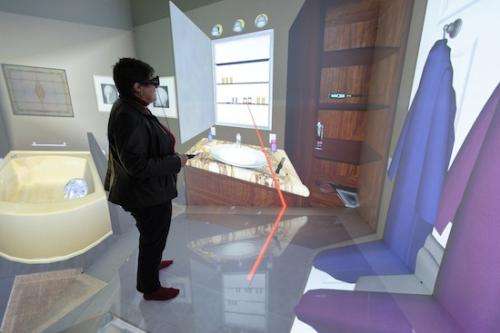Virtually healthy: 'CAVE' lets researchers experience patients' behavior

(Medical Xpress)—The majority of health care takes place not in hospitals and clinics overseen by medical professionals, but in the home.
Every day, patients take prescription medications, monitor vital signs or blood glucose levels, and even administer their own preventative care in the form of exercise and diet choices. It's important for health care providers to understand how their patients actually perform these activities—yet do so without invading patients' privacy.
Virtual reality makes that goal a reality.
Tucked away in a deep corner of the Wisconsin Institutes for Discovery building on the University of Wisconsin–Madison campus, the "CAVE" gives Patricia Flatley Brennan, the Moehlman-Bascom Professor of Industrial and Systems Engineering and Nursing, virtual access to what life is like in a patient's home.
Housed in Brennan's Living Environments Laboratory, the CAVE (Cave Automatic Virtual Environment) uses a series of projectors in a cube-shaped room to create virtually any space imaginable. A kitchen, a bathroom, and other home settings are shown. There's also an interactive operating room. The CAVE is an immersive, experiential world in which researchers and test subjects can turn faucets on and off—and hear the sound of water. Pill bottles rattle when shaken. Door and cabinet hinges squeak. Outside the kitchen window is a stunning, lifelike view of Niagara Falls.
It's the perfect place to simulate and test at-home health care situations and processes. For example, many diabetics measure their blood sugar levels using a glucometer—a small, inconspicuous device. In a home environment, such as a teenager's bathroom, clutter might make it difficult to find when needed. Medicine bottles themselves might need a redesign: In hospitals, they make sense, but what if a patient's medicine cabinet has very narrow shelves? The bottles tip and fall easily. And, says Brennan, "People think that patients sit down at tables when they do paperwork. They don't. They sit at kitchen counters."
Besides addressing these more practical problems, one of Brennan's projects involves the science of imagination: How can visual cues in the home stimulate people to take better care of themselves—for example, by quitting smoking or exercising? "Think of yourself on a gray day: Things are closing in, buildings look a different color," she says. "Then think of yourself on a sunny day."
Rather than focus on ceasing an activity, Brennan says, it's better to understand why a harmful behavior is meaningful to a person. "Do I smoke because I'm awkward in social situations," she says, "or do I live in a place where there are no extra activities so I tend to eat more? What need is this behavior responding to?"
Collaborating with colleagues that include renowned UW–Madison neuroscientist Richard Davidson, Brennan is studying ways to stimulate changes in the brain to help people more effortlessly make healthier choices. "We could expand their skillset of being able to imagine situations and be creative in their problem solving," she says. "Imagination also has the capability of helping people figure out what's important to them, so it may help them redefine problems."
In the CAVE, Brennan can measure whether an imagination-stimulating experience has an effect on brain patterns that ward off distress or unhealthy desires, like the desire to light up a cigarette. "Then we'll look at what visual cues we can place in clinical or neighborhood settings that might perform that same kind of stimulation," Brennan says.
And, she says, by cultivating people's imagination with visual cues, designers of homes, neighborhoods and clinics could develop patients' ability to avoid health-threatening behaviors and to choose health-promoting behaviors.
The CAVE could lead to other breakthroughs in areas where hands-on research in healthcare settings is either prohibitively expensive, or limited by privacy concerns. For example, one student is using the CAVE to investigate the logistics of how best to organize supplies in operating rooms. Another researcher is testing a display that gives nutrition information to users when they look at food—a tool that could be especially invaluable for diabetics and people with food allergies.
Brennan says the sky's the limit. "In the CAVE, we can experience these things," she says. "Almost anything we dream, we can actually make."
















